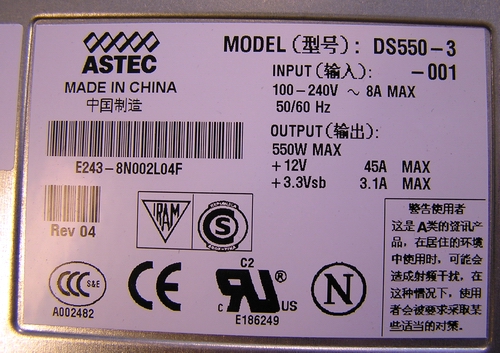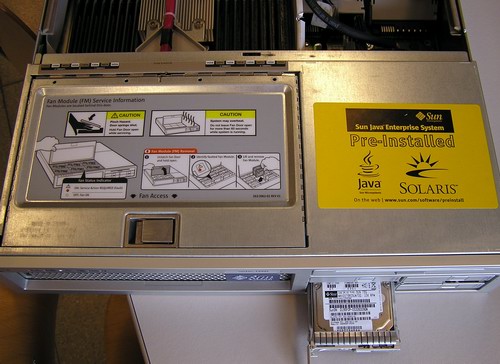Sun’s T2000 “Coolthreads” Server: First Impressions and Experiences
by Johan De Gelas on March 24, 2006 12:05 AM EST- Posted in
- IT Computing
Power
Superb Performance/Watt is what Sun promises with its Coolthreads T2000 server. However, the current T2000 still consumes a bit more power than what they necessarily need. For example, for logistical efficiency reasons, Sun uses a 550 Watt power supply that is also used in the Sun's Galaxy Opteron servers. That power supply will be replaced by a 400-450W more power efficient one later on.
This is the power supply that we used on the Xeon.
The big loser here is, as expected, the Intel Xeon server. The T1 outperformed the dual Xeon 3.6 GHz with a decent, even significant margin and consumes about half the power of the Xeon machine. Add to this that a more efficient 450 Watt power supply will lower the power by another 30 to 40 Watt for the T2000.
The other winner is, of course, the Opteron HE. This CPU could also be used with a more efficient and lower peak power power supply. An Opteron HE is the best x86 alternative for the Sun UltraSparc T1, but fortunately for Sun, this CPU has not yet been picked up by a big OEM like HP or IBM.
First impressions so far
Even if we assume that the exceptional Spec Web 2005 and JBB 2005 numbers, which Sun posted are too optimistic, our own power measurements confirm that the T2000 is much more than yet another Sun Server.
At first sight, Sun has won the performance/watt battle for now, but it cannot rest on its laurels. Low voltage versions of the Xeon "Woodcrest" (Core architecture) and Opteron might be able to come very close to the performance/Watt levels that the T1 offers. Our first impression is also that Sun still has a lot of room for improvement - better power supplies and power management - and it can continue to outperform the x86 servers by a decent to large margin when it comes to performance per Watt.
We also can't shake the feeling that the number of applications, which will really exhibit the kind of exceptional performance that Sun's own heavily optimised benchmarks show, will be quite limited. A slightly annoying issue is indeed the fact that relatively low amounts of FP instructions in your applications may lower the performance of your T2000 significantly. We are not talking about heavy HPC FP crunching applications, but server apps with a bit of FP calculations here and there. Contrary to other servers, 1.5-2% of FP instructions might be enough to make your application less suitable for the T2000. And profiling your applications in depth is not something that all administrators can or like to do. Sun seems to agree quietly, and is very busy with the T2 (Niagara 2), which has one FPU per core.
The price, about $13000 for the tested server (with 8 GB), seems a bit higher than a typical x86 server, even when equipped with redundant power supplies, fans, etc. But as we said, we'll save our final judgment for our next article, when we have access to much more benchmarking data. So far, the Sun T2000 has been one of the best-made servers that we have seen, and while the performance claims of Sun have not (yet?) materialised in our labs, it is definitely the most attractive Sun Server that we, as "x86 server buyers", have seen in years.
Superb Performance/Watt is what Sun promises with its Coolthreads T2000 server. However, the current T2000 still consumes a bit more power than what they necessarily need. For example, for logistical efficiency reasons, Sun uses a 550 Watt power supply that is also used in the Sun's Galaxy Opteron servers. That power supply will be replaced by a 400-450W more power efficient one later on.

This is the power supply that we used on the Xeon.

| System | Configuration | Max Power usage (100% CPU load, W) |
| Dual Opteron 275 HE | 1CPU (275HE) | 4 GB RAM | 149 |
| Dual Opteron 275 | 1CPU | 4 GB RAM | 166 |
| Sun T2000 | 1CPU / 8 Cores | 8 GB RAM | 188 |
| Dual Opteron 275 HE | 2CPU's (275HE) | 4 GB RAM | 192 |
| Dual Opteron 275 HE | 2CPU's (275HE) | 8 GB RAM | 198 |
| Sun T2000 | 1CPU / 8 Cores | 16GB RAM | 208 |
| Sun T2000 | 1CPU / 4 Cores | 32GB RAM | 216 |
| Sun T2000 | 1CPU / 8 Cores | 32GB RAM | 230 |
| Dual Opteron 275 | 2CPU's | 4 GB RAM | 239 |
| Dual Xeon 3.6 GHz | 2CPU's | 8 GB RAM | 374 |
The big loser here is, as expected, the Intel Xeon server. The T1 outperformed the dual Xeon 3.6 GHz with a decent, even significant margin and consumes about half the power of the Xeon machine. Add to this that a more efficient 450 Watt power supply will lower the power by another 30 to 40 Watt for the T2000.
The other winner is, of course, the Opteron HE. This CPU could also be used with a more efficient and lower peak power power supply. An Opteron HE is the best x86 alternative for the Sun UltraSparc T1, but fortunately for Sun, this CPU has not yet been picked up by a big OEM like HP or IBM.
First impressions so far
Even if we assume that the exceptional Spec Web 2005 and JBB 2005 numbers, which Sun posted are too optimistic, our own power measurements confirm that the T2000 is much more than yet another Sun Server.
At first sight, Sun has won the performance/watt battle for now, but it cannot rest on its laurels. Low voltage versions of the Xeon "Woodcrest" (Core architecture) and Opteron might be able to come very close to the performance/Watt levels that the T1 offers. Our first impression is also that Sun still has a lot of room for improvement - better power supplies and power management - and it can continue to outperform the x86 servers by a decent to large margin when it comes to performance per Watt.
We also can't shake the feeling that the number of applications, which will really exhibit the kind of exceptional performance that Sun's own heavily optimised benchmarks show, will be quite limited. A slightly annoying issue is indeed the fact that relatively low amounts of FP instructions in your applications may lower the performance of your T2000 significantly. We are not talking about heavy HPC FP crunching applications, but server apps with a bit of FP calculations here and there. Contrary to other servers, 1.5-2% of FP instructions might be enough to make your application less suitable for the T2000. And profiling your applications in depth is not something that all administrators can or like to do. Sun seems to agree quietly, and is very busy with the T2 (Niagara 2), which has one FPU per core.

The price, about $13000 for the tested server (with 8 GB), seems a bit higher than a typical x86 server, even when equipped with redundant power supplies, fans, etc. But as we said, we'll save our final judgment for our next article, when we have access to much more benchmarking data. So far, the Sun T2000 has been one of the best-made servers that we have seen, and while the performance claims of Sun have not (yet?) materialised in our labs, it is definitely the most attractive Sun Server that we, as "x86 server buyers", have seen in years.










26 Comments
View All Comments
JackPack - Friday, March 24, 2006 - link
Pleasant to read as usual, Johan.BTW, are they letting you keep the T2000?
http://blogs.sun.com/roller/page/jonathan?entry=ni...">http://blogs.sun.com/roller/page/jonathan?entry=ni...
PandaBear - Friday, March 24, 2006 - link
In terms of Branded server it is a good price, but as benchmark have shown, a Dual Opteron running Linux both perform better and use less power. I think people who buy these class of server want support and service (and build quality) and in that case Sun certain would win the whitebox builder no matter how good a Dual Opteron is.Nonetheless it is a good product, for the one who demand this kind of quality. Now Intel's solution really looks bad.
Calin - Friday, March 24, 2006 - link
I don't know what you are talking about - if you would up the memory on the Opteron HE (2CPU of 2 cores) to 32GB, the power consumption would be almost the same (assuming 6W per 4GB of RAM, it would be at 234W. Close enough to be considered equal, I'd say.Also, wouldn't populating all the possible memory slots on the Opteron decrease a bit its performance? I don't know about Opteron, but Athlon64 decrease its command rate (Help, Johan! :) ) when working with all the memory channels filled.
I agree about the better performance of the Opteron server, but regarding the power use, it is the same as the Sun's recent offering. Maybe the introduction of the DDR2 Opterons would change the power envelope, but until then, the T1 might have some aces up its sleeve
JohanAnandtech - Friday, March 24, 2006 - link
You must calculate about 4-5 Watt per 2 GB Dimm. Based on the measurements I did and slightly guessing I think a 32 GB Opteron HE with 32 GB would definitely consume more than The T2000 as also have to count a few Watts per memory channel.Indeed, fully loaded DIMM channels will probably throttle back to lower speeds. I am not sure about Command rate though (BTW, it increases on the Athlon 64 not decreases :-), as it is possible less important with buffered DIMMs.
About performance, we still have to test a lot of scenario's (jsp, databases). The impression of the T2000 might still change.
Zoomer - Sunday, April 9, 2006 - link
2xx Opterons use rigistered ram, so its not an issue like with the 1xx 939s.Calin - Friday, March 24, 2006 - link
I just took the difference measured between the 2xOpteron HE with 4 and 8 GB or RAM (192 and 198W), shown in the table on the last page. I know that even rounding errors might change that between 4 and 8W, but anyway, Opterons won't use less power than the T1.Very interesting article, and I eagerly await for the sequels :D